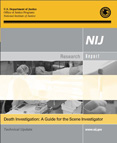|
View in browser: https://www.crime-scene-investigator.net/newsletter/0521.html
|
||
|
MAY 2021 | ||
| ||
|
This Month's Featured Resource on the Crime Scene Investigator Network Website
|
||

This revised and updated edition is the result of a collaborative effort to present the most up-to-date information about the issues confronting death investigators today. The death investigator is the eyes and ears of the forensic pathologist at the scene. It is hoped that these guidelines, reflecting the best practices of the forensic community, will serve as a national standard. |
||
|
New CSI and Forensic Job Announcements
|
||
|
The most comprehensive listing of Crime Scene Investigation and Forensic To be notified of job openings as they are posted, follow us on Twitter: Job Posting Alerts |
||
|
Crime Scene Technician
Wilmington Police Department, Wilmington, North Carolina, USA Final Filing Date: May 23, 2021 Assist officers with the processing of crime scenes and evidence by responding to crime scenes, documenting scenes, collecting and packaging evidence, photographing, video and diagramming scenes and photographing and fingerprinting arrestees. <View complete job listing> |
||
|
Forensic Technician
Richmond Police Department, Richmond, Virginia, USA Final Filing Date: May 30, 2021 respond to any and all crime scenes that occur in the city of Richmond and will properly and completely document these crime scenes using photographs, notes and sketches. Searching, comparing, and evaluating latent and known fingerprints collected as evidence; <View complete job listing> |
||
|
Forensics Technician
Portsmouth Police Department, Portsmouth, Virginia, USA Final Filing Date: May 30, 2021 Identifies, collects, preserves, documents, and processes physical evidence independently from complex crime scenes, and victims and suspects; collects latent fingerprints; photographs and sketches crime scenes; maintains chain of evidence; processes and maintains digital images; <View complete job listing> |
||
|
Evidence Technician
Colorado Springs Police Department, Colorado Springs, Colorado, USA Final Filing Date: May 28, 2021 Retrieve and transport evidence, property, and items for destruction from/to all police divisions. Identify proper storage locations for various types of items, including flammable lockers, refrigerators, freezers, firearms, and narcotics as well as general storage. <View complete job listing> |
||
 |
||
|
Forensic Scientist - Firearms & Toolmarks
Virginia Department of Forensic Science, Norfolk, Virginia, USA Final Filing Date: June 1, 2021 Responsible for examining, comparing, and evaluating a wide variety of items such as various firearms, unfired ammunition, fired ammunition components, clothing, tools and objects bearing toolmarks. <View complete job listing> |
||
|
Forensic Laboratory Director
San Mateo County Sheriff's Office, Redwood City, California, USA Final Filing Date: June 4, 2021 Manage, plan, organize, coordinate, direct, and evaluate the activities and personnel of the forensic laboratory. <View complete job listing> |
||
|
Crime Lab Forensic Scientist 1 - Toxicology
Metro Nashville Police Department, Nashville, Tennessee, USA Final Filing Date: June 14, 2021 Completes training program. May perform casework. Participates in quality assurance/quality control measures. Performs administrative duties. Participates in professional development. Interacts with the judicial system. <View complete job listing> |
||
|
Latent Print Examiner
Lake County Crime Laboratory, Painesville, Ohio, USA Final Filing Date: June 1, 2021 Responsible for examining, processing, comparing, and evaluating a wide variety of items for friction ridge evidence. Document, evaluate, analyze and preserve evidence and utilize various comparison techniques while maintaining the chain of custody. Must be willing to cross train in Firearms and Toolmark analysis and crime scene processing. <View complete job listing> |
||
|
Search for more job listings in Crime Scene Investigations and Forensics To be notified of job openings as they are posted, follow us on Twitter: Job Posting Alerts |
||
|
Other Resources on the Crime Scene Investigator Network Website
|
||
|
Not Subscribed to this Newsletter?
|
||
|
If you are not subscribed to this newsletter, you may subscribe with this link: SUBSCRIBE via email |
||
|
To Unsubscribe
|
||
|
To unsubscribe from future e-mail alerts, please click here: UNSUBSCRIBE Copyright ©2021 Crime Scene Resources, Inc. Crime Scene Investigator Network |

